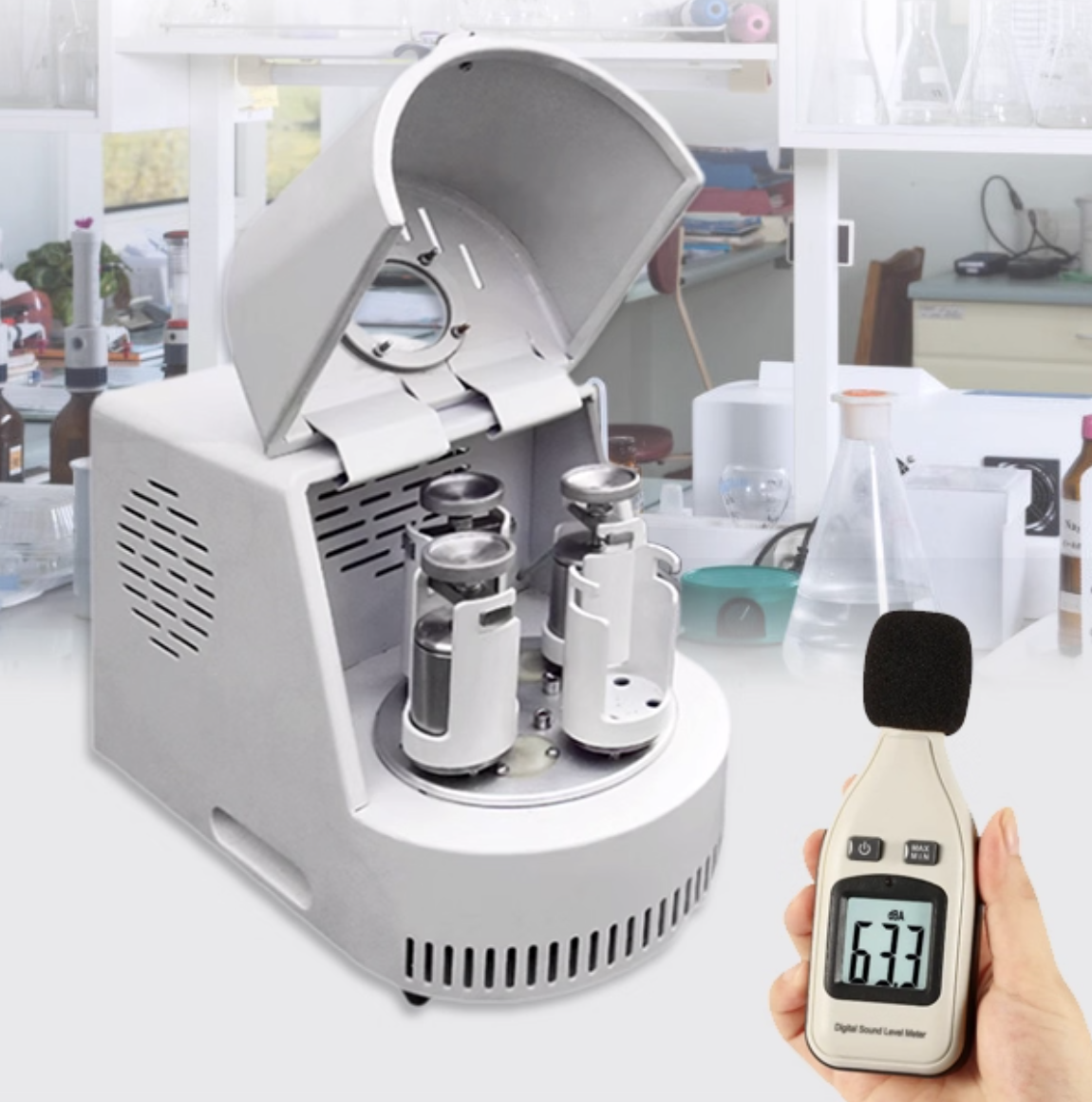The Mill Base (1L capacity): This indicates the size class of the
planetary ball mill machine itself. A "1L" designation typically
means the machine is designed to accommodate one or more grinding
jars whose total volume adds up to approximately 1 liter. For
example, it could hold four 250ml jars or, as in this case, it is
perfectly compatible with smaller jars like a 100ml tank.
The Grinding Assembly (100ml Zirconia Tank): This is the actual jar
and ball set used for the grinding process, made from
Yttria-Stabilized Zirconia (YSZ).
This combination is ideal for achieving nano-scale fineness with
small, high-value samples.
| Model No. | ZLXQM-0.4 |
|---|
| Volume of each matched Jar | 100ml |
|---|
| Voltage | 220V - 50Hz |
|---|
| Machine Size | 500*300*340mm |
|---|
| Machine Weight | 100 Kg without mill jar |
|---|
| Work mode | 4 jars working together |
|---|
| Mill mode | Dry / wet milling |
|---|
| Speed Frequency | Adjusting |
|---|
| Drive Mode | Gear drive |
|---|
| Rotational Speed | 90-870 r/min, adjusting |
|---|
| revolution: rotation | 1:2.14 |
|---|
| Material Capacity | Material + mill balls < 2/3 volume |
|---|
| Input Granularity Size | < 10mm for soft material,
< 3mm for hard material |
|---|
| Output Granularity Size | Minimum 0.1μm |
|---|
| Field of application | Geology, Mining, Metallurgy, Electronics, Construction Material,
Ceramics, Chemical Engineering, Light Industry Medicine,
Environmental Protection etc. |
|---|
| Feed material | Soft, hard, brittle, fibrous, cellulose, herb, glass, soil,ore,
pharmacy, chemical, fluorescent, pigment etc. |
|---|
| Type of grinding jars | Stainless steel, zirconia, alumina, nylon, PU, tungsten,PTFE etc.,
vacuum jars are available as well. |
|---|
| Type of grinding medium | Stainless steel balls, zirconia balls, alumina balls, PU balls,
steel carbon balls, tungsten balls, etc. |
|---|
| Max. continuous operating time (full-load) | 72 hours |
|---|
| Interval operation | With direction reversal |
|---|
| Certificate | ISO 9001. CE certificate |
|---|
1. Machine Capability: The 1L Planetary Ball Mill
Platform Versatility: The 1L mill is a robust benchtop unit that
provides a stable and powerful drive for the planetary movement.
Its key advantage is flexibility; while it can handle larger
batches with bigger jars, it excels at running smaller jars (like
the 100ml tank) with high efficiency.
High-Energy Input: It generates significant centrifugal force
through the opposing rotations of the planetary disk and the jars,
which is essential for breaking particles down to the nanoscale.
Precise Control: Features digital controls for setting rotation
speed (RPM) and grinding time with high accuracy, ensuring
reproducible results across experiments.
2. Grinding Core: The 100ml Zirconia Tank & Balls
The choice of the 100ml Zirconia assembly is critical for
nano-scale applications.
Material: Zirconia (ZrO₂)
- Extreme Hardness & Wear Resistance: Zirconia is one of the hardest
materials used for milling jars. It minimizes wear and
contamination, which is absolutely vital for nano-grinding where
even tiny amounts of abraded material can skew results.
- High Density: The high density of zirconia grinding balls
translates to greater impact energy during milling, leading to more
effective pulverization.
- Chemical Inertness: Zirconia is chemically inert against most
materials, ensuring the sample purity is maintained. It is ideal
for grinding corrosive or sensitive materials.
Tank Size: 100ml
- Ideal for R&D Quantities: This volume is perfect for processing
small, precious samples (e.g., 1/3 to 1/2 of the jar's volume, so
approx. 10-30 grams of sample plus grinding media). This minimizes
waste and allows researchers to work with expensive or
limited-quantity materials.
- Efficient Energy Use: A smaller jar on a powerful 1L base ensures
that the energy from the planetary motion is effectively
transferred to the small sample mass, preventing the sample from
being "cushioned" and resulting in faster, more efficient grinding.
3. Application Workflow for Nano-Scale Grinding
To achieve nano-scale particles, the process is typically as
follows:
- Loading: The sample material is placed into the 100ml zirconia jar.
Zirconia grinding balls of an appropriate size (e.g., 0.5mm to 3mm
for nano-grinding) are added. The jar should not be filled more
than half full (including balls and sample) to allow for proper
movement.
- Wet Grinding (Recommended for Nano-Scale): A liquid grinding aid or
solvent (e.g., water, ethanol, hexane) is added to cover the sample
and balls. This is crucial for nano-grinding as it:
- Prevents agglomeration of fine particles.
- Cools the sample, reducing heat-induced degradation.
- Aids in creating a stable nano-suspension.
- Parameter Setting: The jar is securely fastened onto the mill. The
speed (often 300-600 RPM) and time (from minutes to several hours)
are set based on the material's hardness and desired fineness.
- Milling: The planetary motion begins, causing the zirconia balls to
impact and frictionally grind the sample against the jar walls.
- Result Extraction: After milling, the resulting nano-powder or
suspension is carefully collected from the zirconia jar.
4. Advantages of This Specific Combination
- Optimal for Nano-Preparation: The high-energy 1L mill paired with
the contamination-free zirconia tank is a proven setup for
achieving particles < 100 nm.
- Minimal Contamination: Zirconia ensures the sample remains pure,
which is critical for analytical techniques like XRD, XRF, and
ICP-MS.
- Small Sample Processing: Perfect for R&D where material is
scarce or expensive.
- Scalability: The 1L platform allows for easy scale-up. Parameters
optimized in the 100ml jar can often be translated to larger jars
for larger batch production.
5. Typical Applications
This system is indispensable in fields requiring the highest level
of sample fineness and purity:
- Advanced Materials Science: Preparation of nano-ceramics, composite
powders, and graphene.
- Pharmaceutical Research: Nano-sizing of active ingredients to
enhance bioavailability.
- Battery Research: Homogenization and nano-grinding of cathode/anode
materials (e.g., LFP, NMC).
- Electronics: Preparation of fine electronic pastes and ceramic
powders.
- Geology: Ultrafine pulverization of geological samples for trace
element analysis.












